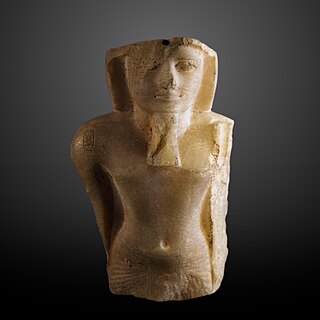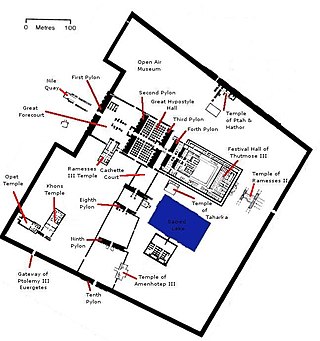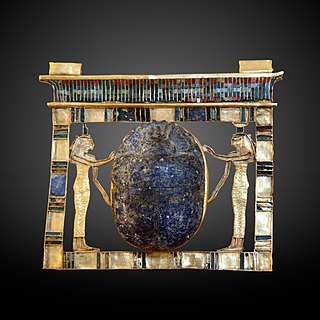
Abydos is one of the oldest cities of ancient Egypt, and also of the eighth nome in Upper Egypt. It is located about 11 kilometres west of the Nile at latitude 26° 10' N, near the modern Egyptian towns of El Araba El Madfuna and El Balyana. In the ancient Egyptian language, the city was called Abdju (Arabic Abdu عبد-و). The English name Abydos comes from the Greek Ἄβυδος, a name borrowed by Greek geographers from the unrelated city of Abydos on the Hellespont. Abydos name in hieroglyphs

Thebes, known to the ancient Egyptians as Waset, was an ancient Egyptian city located along the Nile about 800 kilometers (500 mi) south of the Mediterranean. Its ruins lie within the modern Egyptian city of Luxor. Thebes was the main city of the fourth Upper Egyptian nome and was the capital of Egypt for long periods during the Middle Kingdom and New Kingdom eras. It was close to Nubia and the Eastern Desert, with its valuable mineral resources and trade routes. It was a cult center and the most venerated city during many periods of ancient Egyptian history. The site of Thebes includes areas on both the eastern bank of the Nile, where the temples of Karnak and Luxor stand and where the city was situated; and the western bank, where a necropolis of large private and royal cemeteries and funerary complexes can be found. In 1979, the ruins of ancient Thebes were classified by UNESCO as a World Heritage Site.

Menmaatre Seti I was the second pharaoh of the Nineteenth Dynasty of Egypt during the New Kingdom period, ruling c. 1294 or 1290 BC to 1279 BC. He was the son of Ramesses I and Sitre, and the father of Ramesses II.

Horemheb, also spelled Horemhab or Haremhab, was the last pharaoh of the 18th Dynasty of Egypt. He ruled for at least 14 years between 1319 BC and 1292 BC. He had no relation to the preceding royal family other than by marriage to Mutnedjmet, who is thought to have been the daughter of his predecessor Ay; he is believed to have been of common birth.

Menpehtyre Ramesses I was the founding pharaoh of ancient Egypt's 19th Dynasty. The dates for his short reign are not completely known but the timeline of late 1292–1290 BC is frequently cited as well as 1295–1294 BC. While Ramesses I was the founder of the 19th Dynasty, his brief reign mainly serves to mark the transition between the reign of Horemheb, who had stabilized Egypt in the late 18th Dynasty, and the rule of the powerful pharaohs of his own dynasty, in particular his son Seti I, and grandson Ramesses II.

The Ramesseum is the memorial temple of Pharaoh Ramesses II. It is located in the Theban Necropolis in Upper Egypt, on the west of the River Nile, across from the modern city of Luxor. The name – or at least its French form Rhamesséion – was coined by Jean-François Champollion, who visited the ruins of the site in 1829 and first identified the hieroglyphs making up Ramesses's names and titles on the walls. It was originally called the House of millions of years of Usermaatra-setepenra that unites with Thebes-the-city in the domain of Amon.Usermaatra-setepenra was the prenomen of Ramesses II.

The New Kingdom, also referred to as the Egyptian Empire, was the ancient Egyptian nation between the 16th century BC and the 11th century BC. This period of ancient Egyptian history covers the Eighteenth Dynasty, the Nineteenth Dynasty, and the Twentieth Dynasty. Through radiocarbon dating, the establishment of the New Kingdom has been placed between 1570 BC and 1544 BC. The New Kingdom followed the Second Intermediate Period and was succeeded by the Third Intermediate Period. It was the most prosperous time for the Egyptian people and marked the peak of Egypt's power.

Merneptah or Merenptah was the fourth pharaoh of the Nineteenth Dynasty of Ancient Egypt. He ruled Egypt for almost ten years, from late July or early August 1213 BC until his death on 2 May 1203 BC, according to contemporary historical records. He was the thirteenth son of Ramesses II, only coming to power because all of his older brothers had died, including his full brother Khaemwaset or Khaemwase.

Twosret, also spelled Tawosret or Tausret was the last known ruler and the final pharaoh of the Nineteenth Dynasty of Egypt.
Mortuary temples were temples that were erected adjacent to, or in the vicinity of, royal tombs in Ancient Egypt. The temples were designed to commemorate the reign of the Pharaoh under whom they were constructed, as well as for use by the king's cult after death. Some refer to these temples as a cenotaph. These temples were also used to make sacrifices of food and animals.

The Precinct of Amun-Re, located near Luxor, Egypt, is one of the four main temple enclosures that make up the immense Karnak Temple Complex. The precinct is by far the largest of these and the only one that is open to the general public. The temple complex is dedicated to the principal god of the Theban Triad, Amun, in the form of Amun-Re.

Bay, also called Ramesse Khamenteru, was an important Asiatic official in ancient Egypt, who rose to prominence and high office under Seti II Userkheperure Setepenre and later became an influential powerbroker in the closing stages of the 19th Dynasty. He used to be possibly identified with Irsu mentioned in the Great Harris Papyrus, although no contemporary source connects Bay with Irsu and the connection has since been disproven due to the differences in the years that they died.

The Theban Necropolis is a necropolis on the west bank of the Nile, opposite Thebes (Luxor) in Upper Egypt. It was used for ritual burials for much of the Pharaonic period, especially during the New Kingdom.

The Great Hypostyle Hall is located within the Karnak Temple Complex, in the Precinct of Amon-Re. It is one of the most visited monuments of Ancient Egypt. The structure was built around the 19th Egyptian Dynasty. Its design was initially instituted by Hatshepsut, at the North-west chapel to Amun in the upper terrace of Deir el-Bahri. The name refers to hypostyle architectural pattern.

Kurna are various spelling for a group of three closely related villages located on the West Bank of the River Nile opposite the modern city of Luxor in Egypt near the Theban Hills.

The history of the Karnak Temple complex is largely the history of Thebes. The city does not appear to have been of any significance before the Eleventh Dynasty, and any temple building here would have been relatively small and unimportant, with any shrines being dedicated to the early god of Thebes, Montu. The earliest artifact found in the area of the temple is a small, eight-sided column from the Eleventh Dynasty, which mentions Amun-Re. The tomb of Intef II mentions a 'house of Amun', which implies some structure, whether a shrine or a small temple is unknown. The ancient name for Karnak, Ipet-Isut only really refers to the central core structures of the Precinct of Amun-Re, and was in use as early as the 11th Dynasty, again implying the presence of some form of temple before the Middle Kingdom expansion.

Paser was an ancient Egyptian noble who served as vizier during the reigns of Seti I and Ramesses II in the 19th Dynasty. He would later also become High Priest of Amun.

The Battle of Djahy was a major land battle between the forces of Pharaoh Ramesses III and the Sea Peoples who intended to invade and conquer Egypt. The conflict occurred on the Egyptian Empire's easternmost frontier in Djahy, or modern-day southern Lebanon, in the eighth year of Ramesses III or about c. 1178 BC.

Ramesses II, commonly known as Ramesses the Great, was an Egyptian pharaoh. He was the third ruler of the Nineteenth Dynasty. Along with Thutmose III of the Eighteenth Dynasty, he is often regarded as the greatest, most celebrated, and most powerful pharaoh of the New Kingdom, which itself was the most powerful period of ancient Egypt. He is also widely considered one of ancient Egypt's most successful warrior pharaohs, conducting no fewer than 15 military campaigns, all resulting in victories, excluding the Battle of Kadesh, generally considered a stalemate.

The High Priest of Ptah was sometimes referred to as "the Greatest of the Directors of Craftsmanship". This title refers to Ptah as the patron god of the craftsmen.






















